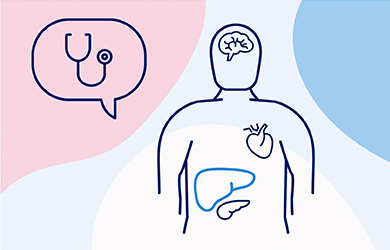
What is GLP-1 and how does it work
Glucagon-like peptide 1 (GLP-1) is a naturally occurring hormone in the body. Although its production is inhibited in people with type 2 diabetes, its function remains possible.
Glucagon-like peptide 1 (GLP-1) is a naturally occurring hormone in the body. Although its production is inhibited in people with type 2 diabetes, its function remains possible.
Therefore, GLP-1 RA (receptor agonist) treatments have been developed to mimic the function of GLP-1 and increase its activity as it occurs in healthy people.
GLP-1 RA is a class of non-insulin medication that assists your body’s natural ability to regulate blood sugar and appetite.
This, in turn, helps to reduce the risk of major cardiovascular events such as heart attack and stroke, by preventing arterial damage in people with type 2 diabetes who have established cardiovascular disease.
Want to know more about glucose-lowering medication with proven cardiovascular benefits that also supports weight loss?
1. Kim W, Egan JM. Pharmacol Rev. 2008;60:470-512
2. Flint A, Raben A, Ersboll AK, et al. Int J Obes Relat Metab Disord. 2001;25:781-792
3. Ahmann AJ, Capehorn M, Charpentier G, et al. Diabetes Care. 2018;41:258- 266.
4. Ahrén B, Masmiquel L, Kumar H, et al. Lancet Diabetes Endocrinol. 2017;5:341-354.
5. Aroda VR, Bain SC, Cariou B, et al. Lancet Diabetes Endocrinol. 2017;5:355-366.
6. Sorli C, Harashima SI, Tsoukas GM, et al. Lancet Diabetes Endocrinol. 2017;5:251- 260.
7. Rodbard H, Lingvay I, Reed J, et al. 52nd Annual Meeting of the EASD, Munich, Germany; 12-16 September 2016.
8. Herrington W, Lacey B, Sherliker P, et al. Epidemiology of Atherosclerosis and the Potential to Reduce the Global Burden of Atherothrombotic Disease. Circulation Research. 2016;118:535-546.
9. National Institute of Health. Atherosclerosis. 2021.